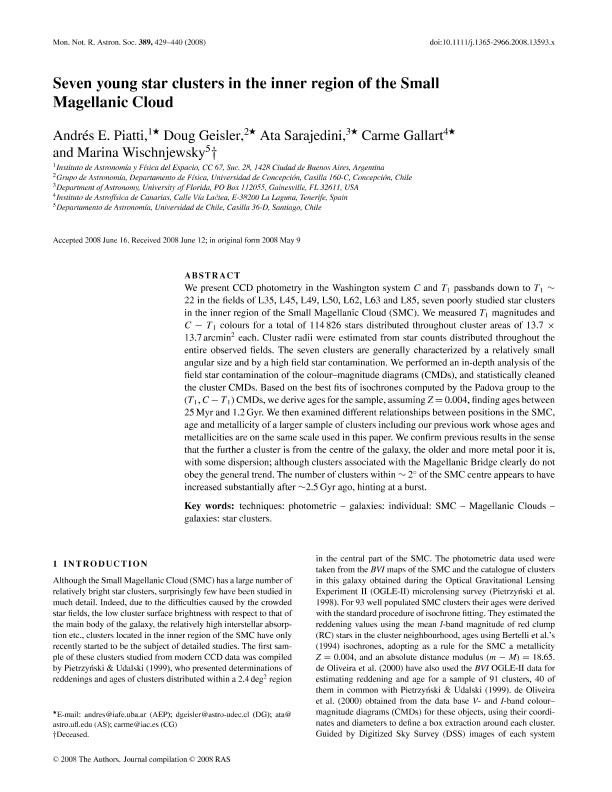Mostrar el registro sencillo del ítem
dc.contributor.author
Piatti, Andres Eduardo

dc.contributor.author
Geisler, Doug
dc.contributor.author
Sarajedini, Ata
dc.contributor.author
Gallart, Carme
dc.contributor.author
Wischnjewsky, Marina
dc.date.available
2017-07-20T20:21:48Z
dc.date.issued
2008-12
dc.identifier.citation
Piatti, Andres Eduardo; Geisler, Doug; Sarajedini, Ata; Gallart, Carme; Wischnjewsky, Marina; Seven young star clusters in the inner region of the Small Magellanic Cloud; Wiley Blackwell Publishing, Inc; Monthly Notices of the Royal Astronomical Society; 389; 1; 12-2008; 429-440
dc.identifier.issn
0035-8711
dc.identifier.uri
http://hdl.handle.net/11336/21039
dc.description.abstract
We present CCD photometry in the Washington system C and T1 passbands down to T1∼ 22 in the fields of L35, L45, L49, L50, L62, L63 and L85, seven poorly studied star clusters in the inner region of the Small Magellanic Cloud (SMC). We measured T1 magnitudes and C−T1 colours for a total of 114 826 stars distributed throughout cluster areas of 13.7 × 13.7 arcmin2 each. Cluster radii were estimated from star counts distributed throughout the entire observed fields. The seven clusters are generally characterized by a relatively small angular size and by a high field star contamination. We performed an in-depth analysis of the field star contamination of the colour–magnitude diagrams (CMDs), and statistically cleaned the cluster CMDs. Based on the best fits of isochrones computed by the Padova group to the (T1, C−T1) CMDs, we derive ages for the sample, assuming Z= 0.004, finding ages between 25 Myr and 1.2 Gyr. We then examined different relationships between positions in the SMC, age and metallicity of a larger sample of clusters including our previous work whose ages and metallicities are on the same scale used in this paper. We confirm previous results in the sense that the further a cluster is from the centre of the galaxy, the older and more metal poor it is, with some dispersion; although clusters associated with the Magellanic Bridge clearly do not obey the general trend. The number of clusters within ∼ 2° of the SMC centre appears to have increased substantially after ∼2.5 Gyr ago, hinting at a burst.
dc.format
application/pdf
dc.language.iso
eng
dc.publisher
Wiley Blackwell Publishing, Inc

dc.rights
info:eu-repo/semantics/openAccess
dc.rights.uri
https://creativecommons.org/licenses/by-nc-sa/2.5/ar/
dc.subject
Cluster
dc.subject.classification
Astronomía

dc.subject.classification
Ciencias Físicas

dc.subject.classification
CIENCIAS NATURALES Y EXACTAS

dc.title
Seven young star clusters in the inner region of the Small Magellanic Cloud
dc.type
info:eu-repo/semantics/article
dc.type
info:ar-repo/semantics/artículo
dc.type
info:eu-repo/semantics/publishedVersion
dc.date.updated
2017-07-18T17:17:10Z
dc.journal.volume
389
dc.journal.number
1
dc.journal.pagination
429-440
dc.journal.pais
Reino Unido

dc.journal.ciudad
Londres
dc.description.fil
Fil: Piatti, Andres Eduardo. Consejo Nacional de Investigaciónes Científicas y Técnicas. Oficina de Coordinación Administrativa Ciudad Universitaria. Instituto de Astronomía y Física del Espacio. - Universidad de Buenos Aires. Facultad de Ciencias Exactas y Naturales. Instituto de Astronomía y Física del Espacio; Argentina
dc.description.fil
Fil: Geisler, Doug. Universidad de Concepción; Chile
dc.description.fil
Fil: Sarajedini, Ata. University of Florida; Estados Unidos
dc.description.fil
Fil: Gallart, Carme. Instituto de Astrof´ısica de Canarias; España
dc.description.fil
Fil: Wischnjewsky, Marina. Universidad de Chile; Chile
dc.journal.title
Monthly Notices of the Royal Astronomical Society

dc.relation.alternativeid
info:eu-repo/semantics/altIdentifier/doi/http://dx.doi.org/10.1111/j.1365-2966.2008.13593.x
dc.relation.alternativeid
info:eu-repo/semantics/altIdentifier/url/https://academic.oup.com/mnras/article-lookup/doi/10.1111/j.1365-2966.2008.13593.x
Archivos asociados
